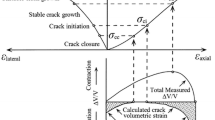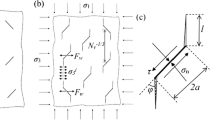Abstract
The growth of subcritical cracks plays an important role in the creep of brittle rock. The stress path has a great influence on creep properties. A micromechanics-based model is presented to study the effect of the stress path on creep properties. The microcrack model of Ashby and Sammis, Charles’ Law, and a new micro–macro relation are employed in our model. This new micro–macro relation is proposed by using the correlation between the micromechanical and macroscopic definition of damage. A stress path function is also introduced by the relationship between stress and time. Theoretical expressions of the stress–strain relationship and creep behavior are derived. The effects of confining pressure on the stress–strain relationship are studied. Crack initiation stress and peak stress are achieved under different confining pressures. The applied constant stress that could cause creep behavior is predicted. Creep properties are studied under the step loading of axial stress or the unloading of confining pressure. Rationality of the micromechanics-based model is verified by the experimental results of Jinping marble. Furthermore, the effects of model parameters and the unloading rate of confining pressure on creep behavior are analyzed. The coupling effect of step axial stress and confining pressure on creep failure is also discussed. The results provide implications on the deformation behavior and time-delayed rockburst mechanism caused by microcrack growth on surrounding rocks during deep underground excavations.


















Similar content being viewed by others
Abbreviations
- a :
-
Radius of initial penny-shaped microcracks
- F w :
-
Wedge force acting on initial microcrack
- D o :
-
Initial damage
- D :
-
Damage
- l :
-
Wing crack length
- l o :
-
Initial equilibrium crack length
- K I :
-
Stress intensity factor for mode I crack
- K IC :
-
Fracture toughness for mode I crack
- m :
-
Material constant
- n :
-
Stress erosion index
- N V :
-
Number of pre-existing cracks per unit volume
- t :
-
Time
- v :
-
Characteristic crack velocity
- α :
-
Cosine value of angle φ
- β :
-
Constant
- ε :
-
Axial strain
- ε e :
-
Axial elastic strain
- ε o :
-
Material constant
- μ :
-
Friction coefficient between microcrack interface
- σ 1 :
-
Axial stress
- σ 1i :
-
Initial value for step loading of axial stress
- σ 1c :
-
Critical stress of crack extension
- σ 1peak :
-
Peak stress corresponding to short-term strength
- σ 3 :
-
Confining pressure
- σ 3i :
-
Initial value for step unloading of confining pressure
- \(\sigma_{3}^{i}\) :
-
Internal stress between two wing crack tips
- σ n :
-
Normal stress on microcrack plane
- Δσ :
-
Step stress value
- τ :
-
Shear stress on microcrack plane
- φ :
-
Angle between each initial microcrack and maximum principal stress σ 1
References
Ashby MF, Hallam SD (1986) The failure of brittle solids containing small cracks under compressive stress states. Acta Metall 34(3):497–510
Ashby MF, Sammis CG (1990) The damage mechanics of brittle solids in compression. Pure Appl Geophys 133(3):489–521
Atkinson BK (1979) A fracture mechanics study of subcritical tensile cracking of quartz in wet environments. Pure Appl Geophys 117(5):1011–1024
Atkinson BK (1984) Subcritical crack growth in geological materials. J Geophys Res 89(B6):4077–4114
Aydan Ö, Ito T, Özbay U, Kwasniewski M, Shariar K, Okuno T, Özgenoğlu A, Malan DF, Okada T (2014) ISRM suggested methods for determining the creep characteristics of rock. Rock Mech Rock Eng 47(1):275–290
Baud P, Meredith PG (1997) Damage accumulation during triaxial creep of darley dale sandstone from pore volumometry and acoustic emission. Int J Rock Mech Min Sci 34(3–4):24.e1–24.e10
Bellenger E, Bussy P (2001) Phenomenological modeling and numerical simulation of different modes of creep damage evolution. Int J Solids Struct 38(4):577–604
Bhat HS, Sammis CG, Rosakis AJ (2011) The micromechanics of Westerley granite at large compressive loads. Pure Appl Geophys 168(12):2181–2198
Boukharov GN, Chanda MW, Boukharov NG (1995) The three processes of brittle crystalline rock creep. Int J Rock Mech Min Geomech Abstr 32(4):325–335
Brantut N, Baud P, Heap MJ, Meredith PG (2012) Micromechanics of brittle creep in rocks. J Geophys Res 117:B08412
Bristow JR (1960) Microcracks, and the static and dynamic elastic constants of annealed and heavily cold-worked metals. Br J Appl Phys 11(2):81–85
Challamel N, Lanos C, Casandjian C (2005) Creep damage modelling for quasi-brittle materials. Eur J Mech A Solids 24(4):593–613
Chandler NA (2013) Quantifying long-term strength and rock damage properties from plots of shear strain versus volume strain. Int J Rock Mech Min Sci 59:105–110
Charles RJ (1958) Static fatigue of glass. I. J Appl Phys 29(11):1549–1553
Chen ZH, Tang CA, Huang RQ (1997) A double rock sample model for rockbursts. Int J Rock Mech Min Sci 34(6):991–1000
Costin LS (1985) Damage mechanics in the post-failure regime. Mech Mat 4(2):149–160
Cruden DM (1970) A theory of brittle creep in rock under uniaxial compression. J Geophys Res 75(17):3431–3442
Damjanac B, Fairhurst C (2010) Evidence for a long-term strength threshold in crystalline rock. Rock Mech Rock Eng 43(5):513–531
Deshpande VS, Evans AG (2008) Inelastic deformation and energy dissipation in ceramics: a mechanism-based constitutive model. J Mech Phys Solids 56(10):3077–3100
Eslami J, Hoxha D, Grgic D (2012) Estimation of the damage of a porous limestone using continuous wave velocity measurements during uniaxial creep tests. Mech Mater 49:51–65
Evans AG (1972) A method for evaluating the time-dependent failure characteristics of brittle materials—and its application to polycrystalline alumina. J Mater Sci 7(10):1137–1146
Fabre G, Pellet F (2006) Creep and time-dependent damage in argillaceous rocks. Int J Rock Mech Min Sci 43(6):950–960
Grgic D, Amitrano D (2009) Creep of a porous rock and associated acoustic emission under different hydrous conditions. J Geophys Res 114:B10201
He MC, Miao JL, Feng JL (2010) Rock burst process of limestone and its acoustic emission characteristics under true-triaxial unloading conditions. Int J Rock Mech Min Sci 47(2):286–298
He MC, Nie W, Zhao ZY, Guo W (2012) Experimental investigation of bedding plane orientation on the rockburst behavior of sandstone. Rock Mech Rock Eng 45(3):311–326
Heap MJ, Baud P, Meredith PG, Bell AF, Main IG (2009) Time-dependent brittle creep in Darley Dale sandstone. J Geophys Res 114:B07203
Heap MJ, Baud P, Meredith PG, Vinciguerra S, Bell AF, Main IG (2011) Brittle creep in basalt and its application to time-dependent volcano deformation. Earth Planet Sci Lett 307(1–2):71–82
Jin F, Zhang CH, ASCE M, Wang G, Wang GL (2003) Creep modeling in excavation analysis of a high rock slope. J Geotech Geoenviron Eng 129(9):849–857
Johnson LR, Sammis CG (2001) Effects of rock damage on seismic waves generated by explosions. Pure Appl Geophys 158(11):1869–1908
Kachanov ML (1982) A microcrack model of rock inelasticity part II: propagation of microcracks. Mech Mater 1(1):29–41
Kachanov LM (1986) Introduction to continuum damage mechanics. Martinus Nijhoff, Dordrecht
Kostrov VV (1974) Seismic moment and energy of earthquakes, and seismic flow of rock. Izv Acad Sci USSR Phys Solid Earth 1:23–44
Krajcinovic D (1983) Constitutive equations for damaging materials. J Appl Mech 50(2):355–360
Kranz RL (1979) Crack growth and development during creep of Barre granite. Int J Rock Mech Min Sci Geomech Abstr 16(1):23–35
Lacroix P, Amitrano D (2013) Long-term dynamics of rockslides and damage propagation inferred from mechanical modeling. J Geophys Res 118(4):2292–2307
Lemaitre J, Plumtree A (1979) Application of damage concepts to predict creep-fatigue failures. J Eng Mater Technol 101(3):284–292
Liu GT, Gao H, Chen FQ (2002) Microstudy on creep of concrete at early age under biaxial compression. Cem Concr Res 32(12):1865–1870
Lockner D, Byerlee J (1977) Acoustic emission and creep in rock at high confining pressure and differential stress. B Seismol Soc Am 67(2):247–258
Ma L, Daemen JJK (2006) An experimental study on creep of welded tuff. Int J Rock Mech Min Sci 43(2):282–291
Mallet C, Fortin J, Guéguen Y, Bouyer F (2014) Evolution of the crack network in glass samples submitted to brittle creep conditions. Int J Fract 190(1–2):111–124
Mallet C, Fortin J, Guéguen Y, Bouyer F (2015) Brittle creep and subcritical crack propagation in glass submitted to triaxial conditions. J Geophys Res 120(2):879–893
Martin CD, Chandler NA (1994) The progressive fracture of Lac du Bonnet granite. Int J Rock Mech Min Sci Geomech Abstr 31(6):643–659
Miura K, Okui Y, Horii H (2003) Micromechanics-based prediction of creep failure of hard rock for long-term safety of high-level radioactive waste disposal system. Mech Mater 35(3):587–601
Munson DE (1997) Constitutive model of creep in rock salt applied to underground room closure. Int J Rock Mech Min Sci 34(2):233–247
Nara Y, Takada M, Mori D, Owada H, Yoneda T, Kaneko K (2010) Subcritical crack growth and long-term strength in rock and cementitious material. Int J Fract 164(1):57–71
Nara Y, Yamanaka H, Oe Y, Kaneko K (2013) Influence of temperature and water on subcritical crack growth parameters and long-term strength for igneous rocks. Geophys J Int 193(1):47–60
Ohnaka M (1983) Acoustic emission during creep of brittle rock. Int J Rock Mech Min Sci Geomech Abstr 20(3):121–134
Ranaivomanana N, Multon S, Turatsinze A (2013) Tensile, compressive and flexural basic creep of concrete at different stress levels. Cem Concr Res 52:1–10
Rice JR (1975) Continuum mechanics and thermodynamics of plasticity in relation to microscale deformation mechanisms. Constitutive equations in plasticity. Massachusetts Institute of Technology Press, Cambridge, pp 23–79
Scholz CH (1968) Mechanism of creep in brittle rock. J Geophys Res 73(10):3295–3302
She CX, Cui X (2010) Influence of high pore water pressure on creep properties of rock. Chin J Rock Mech Eng 29(8):1603–1609
Singh DP (1975) A study of creep of rocks. Int J Rock Mech Min Sci Geomech Abstr 12(9):271–276
Walsh JB (1965a) The effect of cracks on the compressibility of rock. J Geophys Res 70(2):381–389
Walsh JB (1965b) The effect of cracks in rocks on Poisson’s ratio. J Geophys Res 70(20):5249–5257
Wan LH, Cao P, Huang YH, Wang YX (2010) Study on subcritical crack growth of rocks and threshold values in different environments. Chin J Rock Soil Mech 31(9):2737–2742
Wang TJ, Lou ZW (1990) A continuum damage model for weld heat affected zone under low cycle fatigue loading. Eng Fract Mech 37(4):825–829
Wang B, Zhu JB, Wu AQ, Hu JM, Xiong ZM (2008) Experimental study on mechanical properties of jinping marble under loading and unloading stress paths. Chin J Rock Mech Eng 27(10):2138–2145
Weibull W (1951) A statistical distribution function of wide applicability. J Appl Mech 18(2):293–297
Xia CC, Yan ZJ, Wang XD, Zhang CS, Zhao X (2009) Research on elasto-viscoplastic constitutive relation of marble under unloading condition. Chin J Rock Mech Eng 28(3):459–466
Yang C, Daemen JJK (1997) Temperature effects on creep of tuff and its time-dependent damage analysis. Int J Rock Mech Min Sci Geomech Abstr 34(3):383–384
Yang W, Zhang Q, Li S, Wang S (2014) Time-dependent behavior of diabase and a nonlinear creep model. Rock Mech Rock Eng 47(4):1211–1224
Zhang M, Li ZK, Su X (2005) Probabilistic volume element modeling in elastic damage analysis of quasi-brittle materials. Chin J Rock Mech Eng 24(23):4282–4288
Zhang ZL, Xu WY, Wang W, Wang RB (2012) Triaxial creep tests of rock from the compressive zone of dam foundation in Xiangjiaba Hydropower Station. Int J Rock Mech Min Sci 50:133–139
Author information
Authors and Affiliations
Corresponding author
Rights and permissions
About this article
Cite this article
Li, X., Shao, Z. Investigation of Macroscopic Brittle Creep Failure Caused by Microcrack Growth Under Step Loading and Unloading in Rocks. Rock Mech Rock Eng 49, 2581–2593 (2016). https://doi.org/10.1007/s00603-016-0953-9
Received:
Accepted:
Published:
Issue Date:
DOI: https://doi.org/10.1007/s00603-016-0953-9




